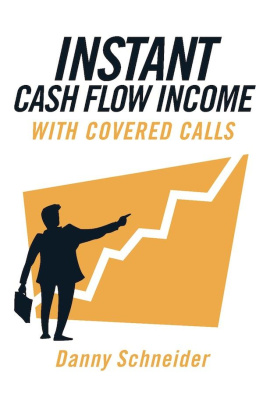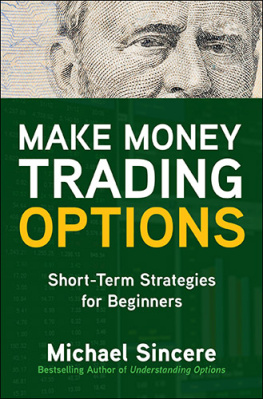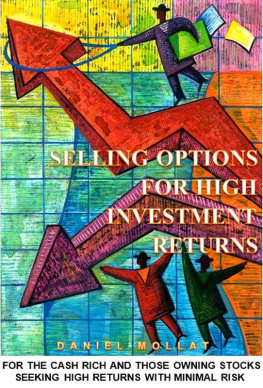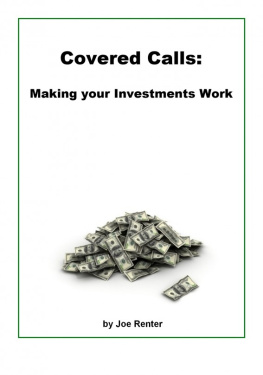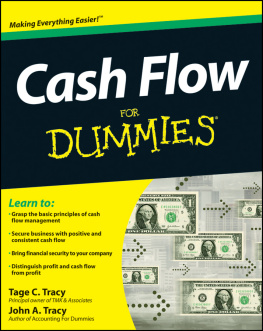
ISBN: 9781626754614
Many people do not believe that option trading---specifically writing covered calls--- is a much safer and very lucrative alternative to simply trading stocks. No, no...Ive heard all about options and how they are too risky. You can lose your shirt, they say.
In actuality, covered calls more accurately should be called a little secret of the stock market. Traders recoil from them because they have a fear of writing options or because they do not understand them.
Truthfully, and going against conventional wisdom, writing covered calls are one of the safest, most consistent ways of achieving high yields in the market! More precisely, they should be described as a conservative, almost bearish, market strategy.
The moment you write a covered call, you instantly receive an upfront premium. This premium automatically makes it less risky than simply owning the stock because your downside risk is now reduced by the dollar amount of the premium you just received. This premium instantly appears in your account the second you sell (write) the covered call.
Another way of putting it is if you buy a stock for $25.00 a share, then sell a covered call for $4.00 a share, you cannot lose money until the stock goes below $21.00 a share.
If you simply own the stock and it goes down, you start losing money the minute it goes below your original purchase price of $25.00.
The concepts and the processes are not difficult to understand. This book seeks to present a very clear and very simple step-by-step explanation---like a recipe---of writing covered calls.
You, too, can reap profits from this little secret of the market. Why leave money on the table?
(Disclaimer: All trading has risk. Trade at your own risk. The author is not giving trading advice and assumes no liability for any loss a reader may incur).
Lets get through some basic terminology and definitions relating to covered calls. First, we have to define an option and the different types of options.
An option is a contract that gives the holder (speculator) the right to buy or sell a particular stock at a specific price up to a specific date.
The specific price is called the strike price.
The specific date is called the expiration date. The expiration date is always the thirdFriday of the month.
Options are derivatives. Though they are traded separately just like stocks, with a bid and an ask price, their value is derived from the value of the underlying assetthe stock.
A call option gives the holder the right (but not an obligation) to buy a particular stock at a specific price up to a specific date.
A put option gives the holder the right (but not the obligation) to sell a particular stock at a specific price up to a specific date.
We are going to concern ourselves with a certain type of call option: covered calls.
A covered call is when you already own a stock and you agree to sell to a speculator the right (the option) to buy it from you at a specific price (strike price) up to a specific date (expiration date). Remember, the specific datethe expiration dateis always the third Friday of each month. Its that simple. You immediately receive an upfront premium that goes directly into your account the second you sell the covered call option. This premium is yours to keep and spend as you wish, no matter what.
Options (including covered calls) are bought and sold in contracts. Each contract is equal to 100 shares of an underlying stock. For example: 3 contracts = 300 shares of stock, 5 contracts = 500 shares of stock, 10 contracts = 1000 shares of stock.
A leap is simply an option that has an expiration date of longer than a year.
Those are most of the basic terms. As with anything, there are a few more as you get into it. As Im sure you can imagine, these terms will soon become second nature to you.
The first and most important thing to remember is that you must first already own the underlying stock before you can sell the covered call.
You are getting a premium by selling a speculator the right to buy your stock at a specified price by a specified date. You pocket this premium.
(There is another transaction called a naked call where you sell the right to a speculator to buy a stock at a specific price by a specific date without actually owning the stock---they are very risky. We wont be dealing with naked calls in this guide).
If you want to do this covered call transaction with a stock that you do not presently own, then you must buy it before you can sell the call. (Remember, all options including covered calls are sold in contracts. Each contract = 100 shares).
If you are going to sell a covered call on a new stock, one that you do not presently own, then it is important to sell to open the covered call immediately after buying the stock.
This is because if the price of the stock drops before you are able to sell the call, the call price (your premium) will fall at a faster rate than the stock.
The best and easiest thing to do is to find an on-line broker that does buy-writes. These eliminate the need for two separate transactions. Both the buying of the stock and the selling of the call are done simultaneously. (TradeMonster.com is an example of an on-line broker that does buy-writes).
Either way of completing the transaction is fine. Just remember to both buy the stock and sell the call at the same time if you are selling the call on a new stock that you do not already own.
This is a basic covered call transaction:
You own 100 shares (1 contract) of a stock.
The stock cost you $24.00 per share.
A speculator wants to pay you $3.00 per share (the premium)for the right (the option)--to buy your $24.00 stock for $26.00 (the strike price) --by the third Friday of next month (the expiration date).
If you enter into this transaction, the $3.00 premium immediately goes into your account.
There are only two things that can happen after you commit to this transaction:
Outcome No. 1
Its the third Friday of the month (the expiration date) and your $24.00 stock closes above the $26.00 strike price.
In this scenario, you lose (sell) the stock for the agreed strike price of price of $26.00. This is a $2.00 profit from the sale of the stock.
Plus, you keep the $3.00 premium.
Total is $29.00 or 21.8 percent. This in just a few short weeksnot bad.
The only problem is that if the stock zoomed up to $35.00, you still have to sell the stock for the agreed strike price of $26.00.
Though no one should be unhappy with a 21.8 percent return in just a few weeks, this does occasionally happen. You just have to say, Oh, well. The speculator took the risk and is looking good but I cant complain about my 21.8 percent profit!
Here is a little story. It can be used as a second example of a transaction scenario where the stock goes up more than expected:
Once upon a time, Tim bought WXYZ for $5.00/share. He was paid a $1.00/share premium to sell it for $5.50/share on the expiration date, which was in approximately three weeks.
He thought, correctly, that this was a great deal. If the stock went above $5.50, he would sell the stock for $5.50 (.50 profit/share) and keep the $1.00/share premium for a total of $1.50/share (30 percent profit) in just three weeks!
Well, four days later, WXYZ shot up to $15.00, but he was still locked into his agreed selling price of $5.50/share. The speculator who paid the $1.00 premium to buy his $5.00 stock for $5.50 in three weeks took a pretty big risk and came out looking good.
Next page
